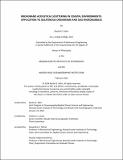Broadband acoustical scattering in coastal environments: application to gelatinous organisms and gas microbubbles
Author(s)
Kahn, Rachel E.
DownloadThesis PDF (19.95Mb)
Advisor
Lavery, Andone C.
Terms of use
Metadata
Show full item recordAbstract
Broadband acoustical technology revolutionized our ability to explore, monitor, and operate in the ocean. While strides have been made in numerous physical and biological applications, there remain many standing scientific questions well suited to broadband approaches. Physics-based sound scattering models allow us to interpret and draw quantitative observations from measurements. Such models have been developed and used to assess the biomass of many types of marine organisms of ecological significance, but we lack rigorous scattering models for gelatinous organisms despite their possibly accounting for a significant proportion of global marine biomass. Additionally, acoustical techniques for characterizing microbubble populations have been established for decades, yet little is known about the spectral characteristics of dense microbubble clouds associated with estuarine tidal fronts. These bubbles facilitate air-sea gas exchange and could interfere with acoustical operations in coastal environments; however, the density and size distribution of the bubbles must be known to assess their impacts. This dissertation addresses these deficiencies in our application of broadband techniques. In Chapter 2, a sound scattering model for gelatinous organisms is developed based on the Distorted Wave Born Approximation. The 3-D model is applied to a species of scyphomedusa and verified with laboratory measurements of broadband backscattering from live individuals. The model predicts backscattering levels and broad spectral behavior within <2 dB. In Chapter 3, a towable instrument is developed for measuring broadband excess attenuation from bubbles from which the size distribution is inferred. The instrument is tested under breaking waves in a laboratory wave tank and then used to characterize the bubble size distribution in the Connecticut River tidal ebb plume front. In Chapter 4, broadband backscattering measurements from the Connecticut River front are used to infer the associated bubble size distribution. Spatial trends in the bubble size distribution are examined within the context of frontal kinematics. An observed disparity between the bubble size distribution measured with excess attenuation and volume backscattering is hypothesized to arise from a sampling bias caused by bubbles concentrated in the upper water column.
Date issued
2024-02Department
Massachusetts Institute of Technology. Department of Mechanical Engineering; Joint Program in Oceanography/Applied Ocean Science and EngineeringPublisher
Massachusetts Institute of Technology